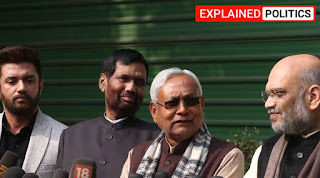a) Voter turnout is going to be lowest in many and many years not only as Corona is in the air but also not much enthusiasm is in general public either for the govt or for any alternative to the govt.
b) In few segments there is anti-incumbency against the current regime and Nitish being head of the govt, JDU will have to face it bluntly. Lack of jobs in the state and rampant migration to other states are the major fire brewing factors. Corona has added more fuel to this.
c) Many voters are looking for alternative parties and right candidates. In absence of that, there will be a good number of ‘NOTA’ votes. Others and independent candidates will also gain in this election. Winning margins will be very thin on many seats.
c) Bihar elections have widely spread into five blocks: NDA , Mahagathbandhan , LJP , Upendra Kushwaha led block and the public. While kushwaha block is more of ‘vote katwa’ what is called in local political language than the real winners and it will damage more to JDU than any other parties. d) LJP maneuvering to contest solely is not what meets the eyes. The induction of leaders from BJP and Sangh cadres into the LJP is a well-thought strategy of BJP to keep JDU within the limits. It can not rely on Nitish any more after the 2015 assembly elections. There will be sympathy votes for Late Ramvilas Paswan and it will help LJP at least on few seats for sure.e) BJP is in pursuit of crossing 90 seats and will help LJP to cross 30 seats at least. It will give BJP the magic number to cross with the help of a few independents or others. BJP wants to be in a position to take a big brother seat in the alliance or maybe the driver seat if needed. Few names that are doing rounds in BJP circle for CM candidates are Ravi Shankar Prasad, Nityanand Rai.
f) BJP is relying on Modi’s popularity and the work is done by the central govt rather than state govt. But the voters of Bihar will vote differently in assembly than what they did in 2019 Lok Sabha elections. Caste arithmetic, local issues, candidates' credibility will be more important than the rest of the issues. BJP does need wholehearted support of Nitish caste-based voters to sail across.
g) Elections will be tightly contested as educated and middle class the core votes of BJP and somewhat JDU also, will not turn up in droves to vote for them. In addition, the large scale unemployed youths will add salt to the wound of the current govt. Bihar has the highest number of young voters in the country.
h)A major advantage Nitish enjoys is the support of female voters, young as well as old cutting across the caste and creed lines. They will definitely help him. Ban on alcohol, old-age pensions, water taps in every house, scholarships for 12th, and graduate girls are popular schemes among the female voters. Nitish hold on ECB ( extremely backward castes ) and distribution of lots of tickets to Yadavs to breach RJD vote bank may also help him.
Many words and lines can be written in election speculation But in short the path of BJP as well as JDU does not look very smooth but they are still in advantage thanks to inexperienced and incredible RJD leadership as well as the fear of the return of ‘Lalu Raj’.
















